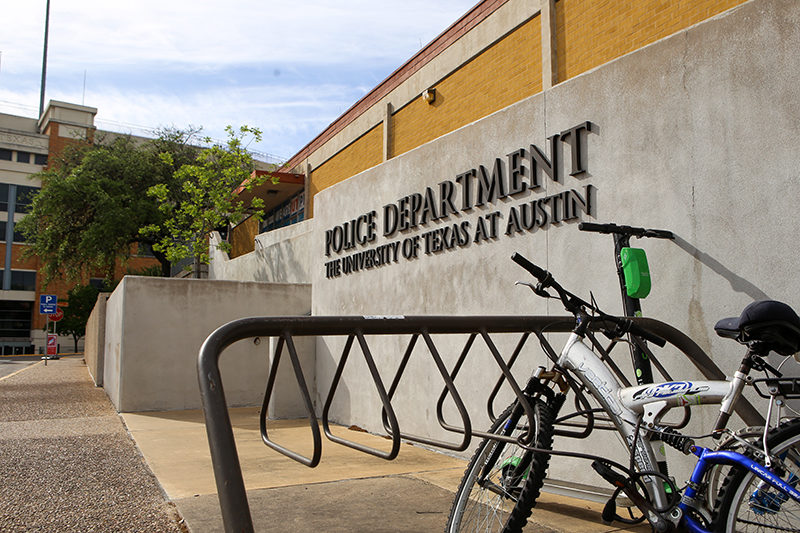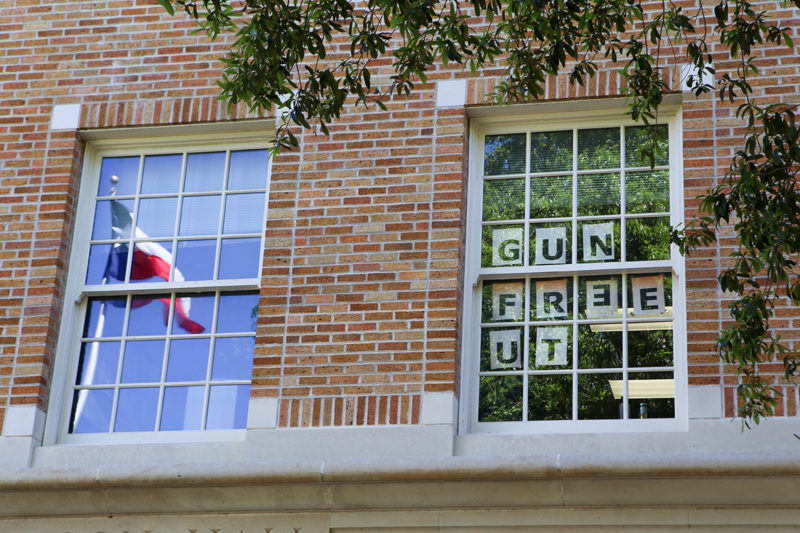UT-Austin, Texas State Train Police, Students and Staff to Handle Active Shooters
By Shepard Price
Reporting Texas

The Police Department at The University of Texas at Austin. Isaiah Zaragoza/Reporting Texas
Twenty years after the Columbine High School Massacre, when two high school students murdered 12 of their classmates and a teacher, school shootings remain a pressing problem — 24 incidents resulting in injury or death made 2018 the worst year for shootings since authorities started tracking them in 1970. Since Columbine, 320 people had been shot on a university or college campus.
Recognizing that grim truth, both the University of Texas at Austin and Texas State University now employ two-track training systems to prepare their campuses for these tragic scenarios.
The first part of the training, entitled ALERRT, or Active Law Enforcement Rapid Response Training, prepares police officers on campus for direct response to the shooters. Thinking about appropriate responses to an active shooter has changed since Columbine, where responding police waited for a SWAT team to arrive before attempting to confront assailants inside a school building.
The second part of the training educates students, faculty and staff on how to increase chances of survival through three-step series of simple responses to the threat.
The key to making the training effective is commitment, says Pete Blair, executive director of the ALERRT center in San Marcos.
“You have to have buy in,” Bair said. “Then you have to have a setup, a plan, that is simple enough that you can practice it and people will remember it.”
For public safety officers, the training is a job requirement. Representatives of Texas State and UT-Austin, including emergency preparedness director Jonathan Robb, say they did not know how many students have completed the training.
“We don’t currently keep track because there are multiple avenues that we promote the training,” Robb said.
An informal survey conducted by Reporting Texas of two dozen UT-Austin students found none had taken the training. Carrington Tatum, a student and editor in chief of the University Star, Texas State’s student newspaper, says the situation is similar at his university.
“I personally haven’t gone through the training and I don’t think my reporters have either,” Tatum said.
The ALERRT training hinges on the reality that active shooter events are short moments, not extended events.
“An active shooter is usually over in three to four minutes,” said Otto Glenewinkel, a member of the Crime Prevention Unit, part of the Texas State Police Department.
Texas State has used ALERRT since 2001. ALERRT’s headquarters are based less than a mile from Texas State’s campus. Training is free to campus police.
In addition to training officers for emergencies, ALERRT has a civilian component that Texas State offers to students, faculty and staff. It focuses on three reactions: avoid, deny and defend. UT-Austin offers a similar civilian training program.
“We encourage the civilians to get out of the environment if at all possible,” Glenewinkel said. “If you can’t avoid the attacker, you have to try and deny the attacker access to your area. You may have to defend yourself if the person gets into your area.”

The Texas flag reflects off the surface of a window next to a “Gun Free UT” sign in the front of Garrison Hall at The University of Texas at Austin. Isaiah Zaragoza/Reporting Texas
Denial focuses on locking and barricading doors, turning out lights, and silencing and darkening cell phones, Glenewinkel said. Because cell phones are often used in emergency situations, they should not be turned off.
Training occurs often and is voluntary, Glenewinkel said. “We’ll go out and train anybody that will listen to us.” That includes at student orientations and for student groups that request it, he added.
Training hasn’t been required at either university yet, and neither has a concrete standard for success.
“Any of our prevention programs are successful from our perspective if the attendees leave with more knowledge and a feeling of confidence in themselves and the UTPD,” Capt. Charles Bonnet said.
UT-Austin also offers a tip line where students can call with concerns, talk to trained staffers and report troubling behavior. Texas State offers two lines, Crime Stoppers and the anonymous text a tip.
Representatives at both Texas State and UT-Austin were unable to say how many tips they had received and how the tips were resolved, as no method of tracking is in place.
Robb stressed that calling the tip line shouldn’t negatively impact relationships and can be completely anonymous. It also doesn’t mean that the person being discussed will face immediate consequences.
“It’s going to create appropriate resources for what the concerning behavior was,” Robb said. “It just means we’re going to assess that situation and provide the appropriate resources.”
Often attackers “broadcast” their intentions, either on social media or to a person they trust, Blair said. Having a place to report it could prevent an incident.
“Any time you can prevent an event, it’s preferable to mitigating one that’s already happened,” Blair said.
Costs associated with these programs include training for police officers, as well as the cost to provide an emergency alert system, providing a police presence and outreach hours and public relation campaigns. Representatives of both universities declined to estimate costs for their programs.
“Any type of safety that we put on campus could relate to an active shooter situation,” Robb said.